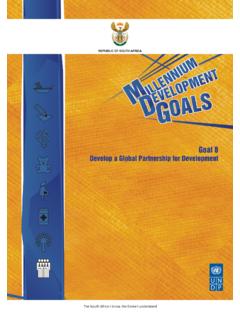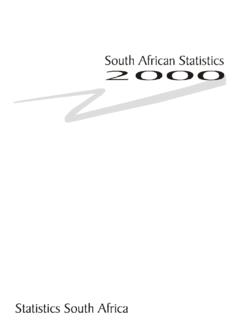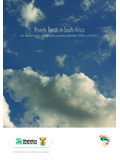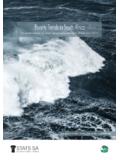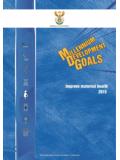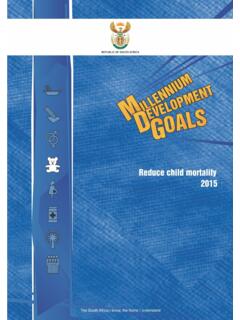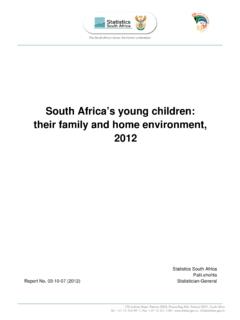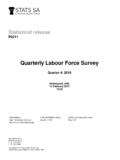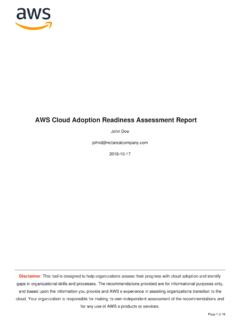Transcription of Strategic plan 2015/2016 – 2019/2020
1 The South Africa I know, the home I understandStrategic plan 2015/2016 2019/2020 Strategic plan 2015/2016 2019/2020 Statistics South AfricaPali Lehohla, Statistician-Generalthe South Africa I know, the South Africa I understandStrategic plan 2015/2016 2019/2020 / Statistics South AfricaPublished by Statistics South Africa, Private Bag X44, Pretoria 0001 Statistics South Africa, 2015 Users may apply or process this data, provided Statistics South Africa (Stats SA) is acknowledged as the original source of the data; that it is specified that the application and/or analysis is the result of the user s independent processing of the data; and that neither the basic data nor any reprocessed version or application thereof may be sold or offered for sale in any form whatsoever without prior permission from Stats SA Library Cataloguing-in-Publication (CIP) DataStrategic plan 2015/2016 2019/2020 / Statistics South Africa.
2 Pretoria: Statistics South Africa, 2015RP123/2015186 ppISBN: 978-0-621-43498-9A complete set of Stats SA publications is available at Stats SA Library and the following libraries:National Library of South Africa, Pretoria DivisionNational Library of South Africa, Cape Town DivisionLibrary of Parliament, Cape TownBloemfontein Public LibraryNatal Society Library, PietermaritzburgJohannesburg Public LibraryEastern Cape Library Services, King William s TownCentral Regional Library, PolokwaneCentral Reference Library, NelspruitCentral Reference Collection, KimberleyCentral Reference Library, MmabathoThis report is available on the Stats SA website: are obtainable from: Printing and Distribution, Statistics South AfricaTel: (012) 310 8093 (012) 310 8251 (012) 310 8358 (012) 310 8161 Fax: (012) 321 7381 Email: by the MinisterForeword by the Chairperson of the Statistics CouncilIntroduction by the Statistician-GeneralChapter 1: The Strategic importance of statistics Chapter 2: Where do we come from and where are we now?
3 Chapter 3: Where do we want to be? Chapter 4: How are we going to get there? Chapter 5: How do we implement? Strategy-in-Action Linking programmes to the strategyAnnexure A: Description of the Strategic planning process Annexure B: The fundamental principles of official statistics Annexure C: African Charter on Statistics Annexure D: List of abbreviations and acronymsAnnexure E: Statistics Act 261013192935107108111158161162165168 ForewordMr JT Radebe (MP)Minister in the Presidency: Planning, Monitoring and Evaluation3 Our supreme law, South Africa s Constitution that enjoins us as a nation and defines our being in the community of nations, declares that South Africa belongs to all who live in it.
4 It recognises the people s struggles, their trials and tribulations as we sought to rid ourselves of the scourge of 300 years of colonial occupation and domination and 46 years of apartheid and systematic racial discrimination. Therefore the preamble says We therefore, through our freely elected representatives, adopt this Constitution as the supreme law of the Republic so as to heal the divisions of the past and establish a society based on democratic values, social justice and fundamental human rights; lay the foundations for a democratic and open society in which government is based on the will of the people and every citizen is equally protected by law; improve the quality of life of all citizens and free the potential of each person; and build a united and democratic South Africa able to take its rightful place as a sovereign state in the family of nations.
5 To achieve the injunction of our Constitution we need to mobilise society through a robust plan and monitor the outcomes of our plans in order to know that our commitment to the Constitution is realised. The Constitution imposes a major burden of responsibility on measurement and our national statistics, which should inform us impartially as an input to the plan and as an instrument of measuring the extent of progress or otherwise towards achieving set goals and targets. Our Constitution is thus unambiguous in its expectations regarding the responsibility of measurement institutions. It further recognises that we are enjoined with the community of nations, thus instructing our system of measurement to adhere to global and international practice.
6 In this regard the Sustainable Development Goals (SDGs) is high on the global agenda post-2015. In order to address these major measurement requirements, I have called for a revamp of the statistical legislation and consolidation of the gains we have made in the area of measurement in the last 20 years. The five-year Strategic plan 2015 2020 shall be judged against the following five goals I have set for the Statistician-General: Firstly, by 2030 our statistical information system will have fully responded to the information demands of the National Development Plan (NDP) that informs development and transformation consistent with the mandate of our Constitution. Secondly, the national statistics system will be driven by a diverse, transformed and united cadre of professionals imbued with the statistical capability to lead the national statistical system.
7 The statistical literacy of citizens and statistical capability in the national statistics system will have increased. School leavers will be better equipped to understand statistical concepts and it application in their daily lives. A new generation of statistical leaders will have been grown to head statistical information systems in the National Statistics System (NSS). A true data revolution will inspire us. Thirdly, Stats SA will be a top-performing organ of state and an employer of choice. Technology will drive an end-to-end robust statistical production system. Our governance and statistical systems are flexible, efficient and innovative, underpinned by sound governance and statistical methodologies. 4the South Africa I know, the home I understandFourthly, Stats SA will be the statistical authority at the heart of the NSS.
8 Collaborative partnerships and statistics units will be established within organs of state under the statistical leadership of the Statistician-General. The production of statistics has now become part of the annual performance plans of organs of state and is used for decision-making by all to inform policy, planning, monitoring and evaluation. Users and the public are delighted and have confidence and trust in official statistics as it is common knowledge and practice that statistics produced in the NSS are based on statistical quality principles and international best practices. Fifthly, by 2020, the statistics value chain will be based on sound statistical quality principles in line with international standards and classifications that engender trust in our products.
9 An enabling statistical legislation is a critical imperative in putting paid the injunction of our supreme law, the Constitution. South Africa has a powerhouse in Statistics South Africa and we need, each one of us, to support the endeavour of science-based planning. I wish to thank the Chair of the Statistics Council, Mr Ben Mphahlele and his Council for providing advice on the compilation of the Strategic plan and the Statistician-General, Mr Pali Lehohla and his staff for putting together this Strategic plan. ForewordBen MphahleleChairperson: Statistics CouncilDemand for official statistics is driven by the global and national commitments to equitable and sustainable development. The Bretton Woods Institution s requirement for the preparation of Poverty Reduction Strategy Papers from client countries and the United Nations Millennium Development Goals gave cause for historic initiatives in the development of statistics.
10 The Marrakech Action Plan for Statistics (MAPS) in 2004 and the Busan Action Plan for Statistics (BAPS) in 2011 are some of the initiatives taken in response to the increasing demand for statistics. MAPS advocated, inter alia, for the mainstreaming of the Strategic planning of statistical systems thus providing grounds for the building of the National Strategies for the Development of Statistics (NSDS), the preparations for the 2010 Census Round and the increase in the financing for statistical capacity building. BAPS built on the successes registered by MAPS and advanced the full integration of statistics in decision-making, open access to statistics and increased investment in statistics Regional Reference Strategic Framework for Statistical Capacity Building in Africa (RRSF) was an African initiative designed to contribute to improved relevance of statistics that meet the users need, improvement of the management of statistical systems and ensuring that the development of statistics on the continent is irreversible and sustainable.
